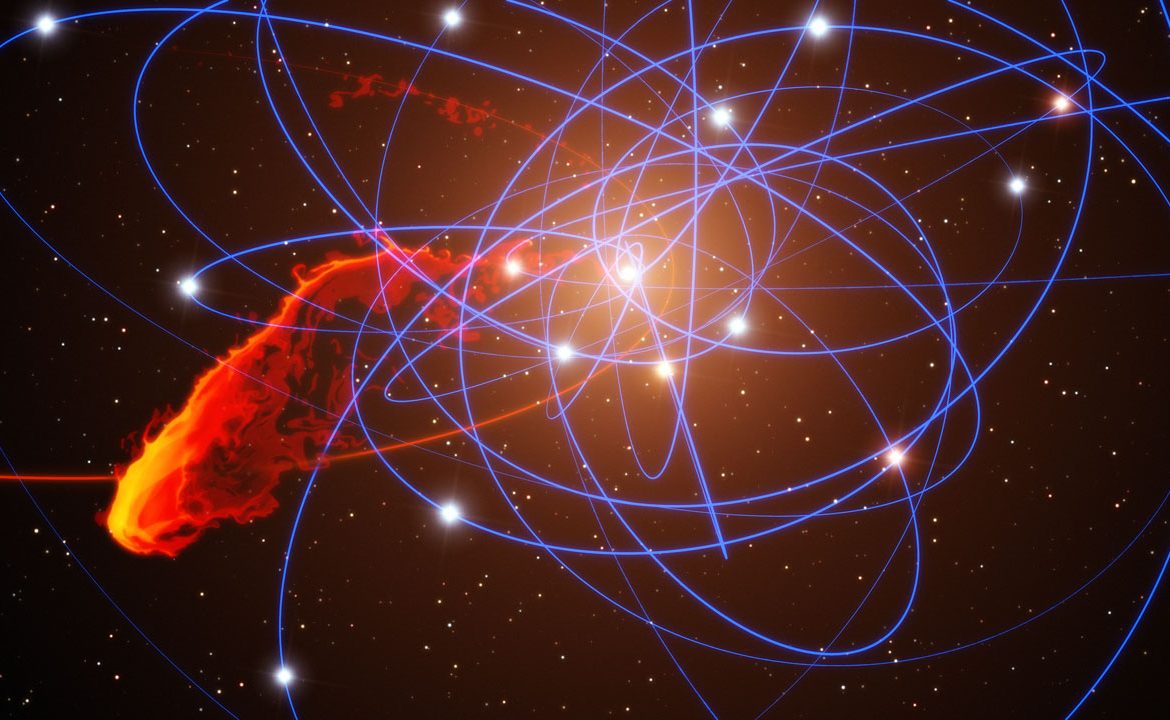Milky Way black hole remains on fast
With up to 400 billion stars in recent estimates, our Milky Way galaxy plays in the giants division. Yet, the supermassive black hole at its center named Sagittarius A* (Sagittarious A star, or Sgr A* for short), packing an impressive looking 4 million Solar masses, becomes a “feather weight” hardly worthy of the title “super” beside behemoths with up to billions of Solar masses at other large galaxies (See: KURIOUS – Wide Angle – Milky Way Black Hole In Sharper Focus) . And not surprisingly, our weakling has long been on a starvation diet. Since it has not ingested anything worth mentioning despite its tremendous gravitational pull that feeds all matter, (and even light) falling inside the Solar System-sized threshold dubbed “event horizon”, to the immensely dense e monster called “singularity” at the center where known laws of physics do not apply, it makes do with asteroids snatched from their orbits around nearby stars.
So, a strange object seen approaching the black hole over the past few years had been keeping the gaze of intrigued astronomers riveted on it. Common assumption was that the object, named G2, was a gigantic cloud of hydrogen, and as it makes a close pass by the monster this past summer, Sgr A* would take a good helping from the matter it contains. As mentioned above, black holes cannot be observed directly since they do not even allow light to escape after it crosses the event horizon. Their presence can be inferred , though, either by the X-rays emitted by matter forming a torus-shaped “accretion disk” around the event horizon and reaching huge speeds and temperatures of millions of degrees before being gulped, or from the great orbital velocities measured for the nearest stars. By monitoring the strength and frequency of the X-rays emanating from the accretion disk, astronomers can form an idea about the diet of the black hole.
Astronomers, regularly observing Sgr A* and its environs with powerful tools (like the twin 10-meter Keck telescopes) to watch G2 meeting its fate, were once again disappointed . The expectation was that the gas cloud would disintegrate as it skirts the black hole, with the guzzled parts causing easily detectable changes in the regime of the incoming X-rays. But when the cloud drew near Sgr A* this past May, no such changes were detected.
“G2 survived and continued happily on its orbit; a simple gas cloud would not have done that,” says Prof. Andrea Ghez of UCLA, an astronomer and a leading authority on Sgr A* who heads the Galactic Center Research Group.
The conclusion Ghez and her team has reached is that G2 is most likely a giant star formed when a pair of stars, orbiting the black hole in a binary system ,merged under the influence of the huge gravitational pull of Sgr A*. This mechanism is thought to work also for other binary stars around the black hole, converting them into supermassive single stars. Ghez proposes that stars in the immediate vicinity of the black hole are binaries composed of massive stars and most of them could have merged in the same way. Noting that the massive star produced through the merger expands for about a million years before it settles down, Ghez and her team speculate that G2 is now at this inflated state. Apart from some abrasion to its envelope, the star emerged largely intact according to Ghez and “would be fine.”
Computer simulation showing G2 approaching the supermassive black hole at Milky Way’s center and drawing away after the close encounter.
Ghez, further adds that G2 is currently (current being 26.000 years ago since the center of the Milky Way is 26.000 light years away from us) in a “spaghetti-fication” process, meaning that it is elongated as objects passing near supermassive blackholes usually are. It is also mostly engulfed in a huge shroud of gas and dust as nearby stars in the thickly populated galactic center heat its surface.
REFERENCES
- 1. “UCLA Astronomers solve puzzle about bizarre object at the center of our galaxy”, University of California –Los Angeles, 3 November 2014



